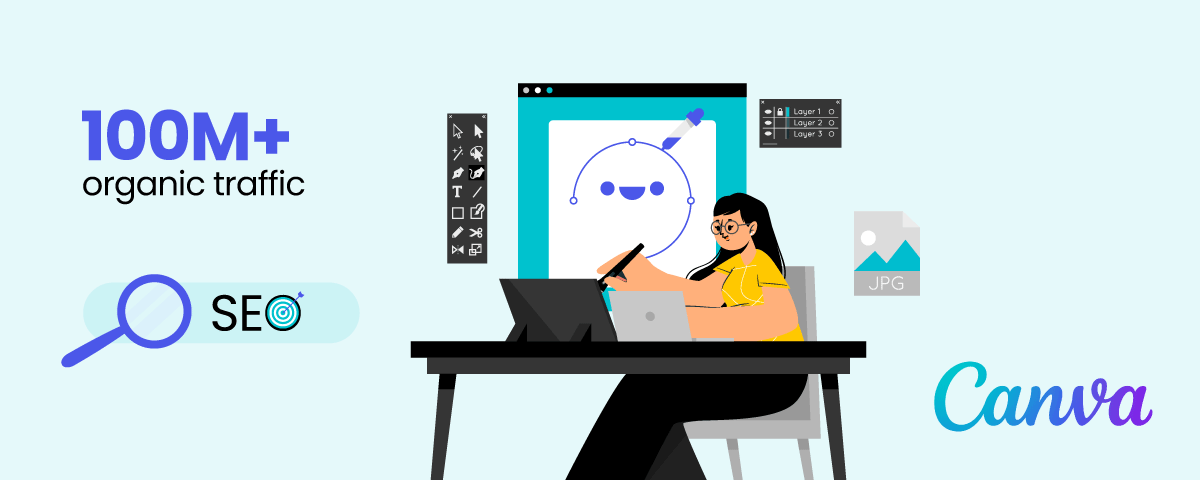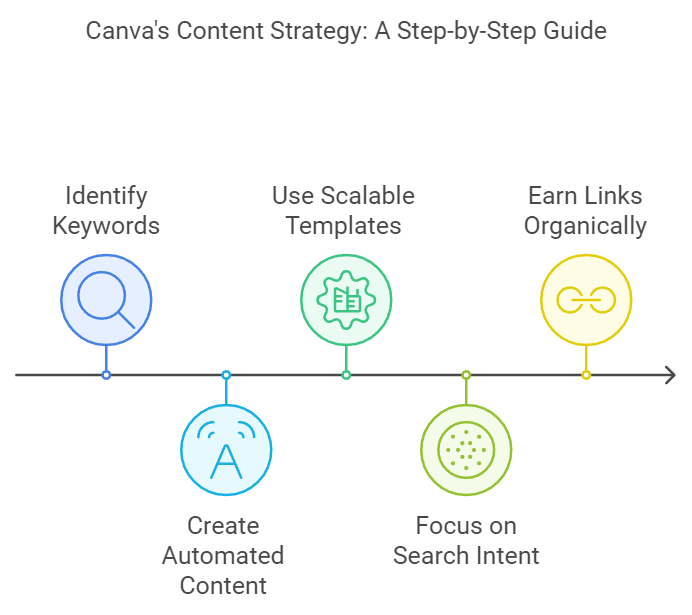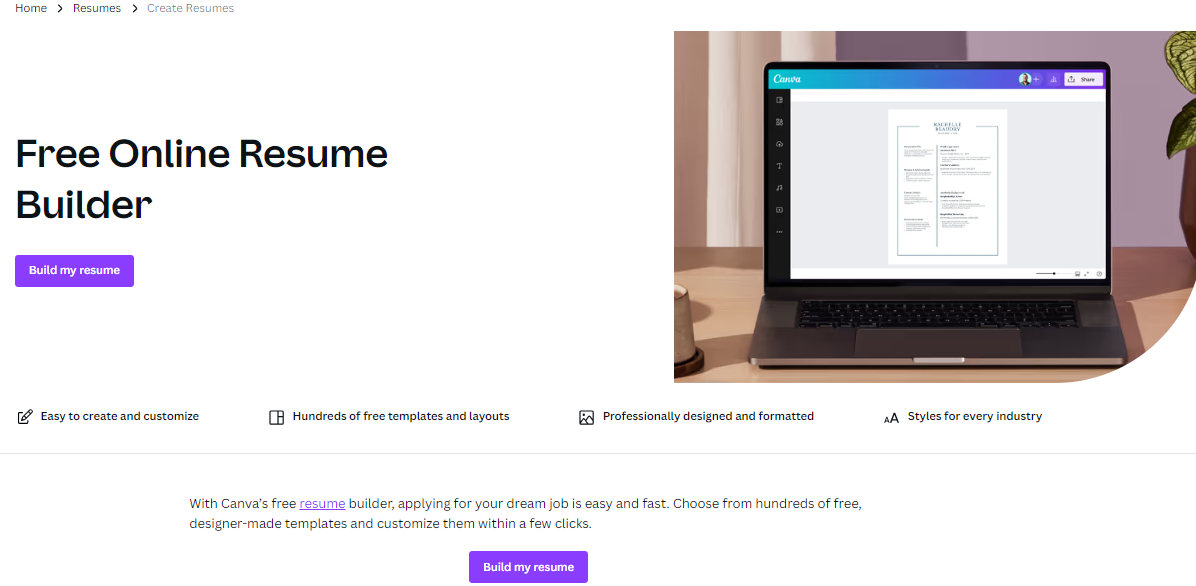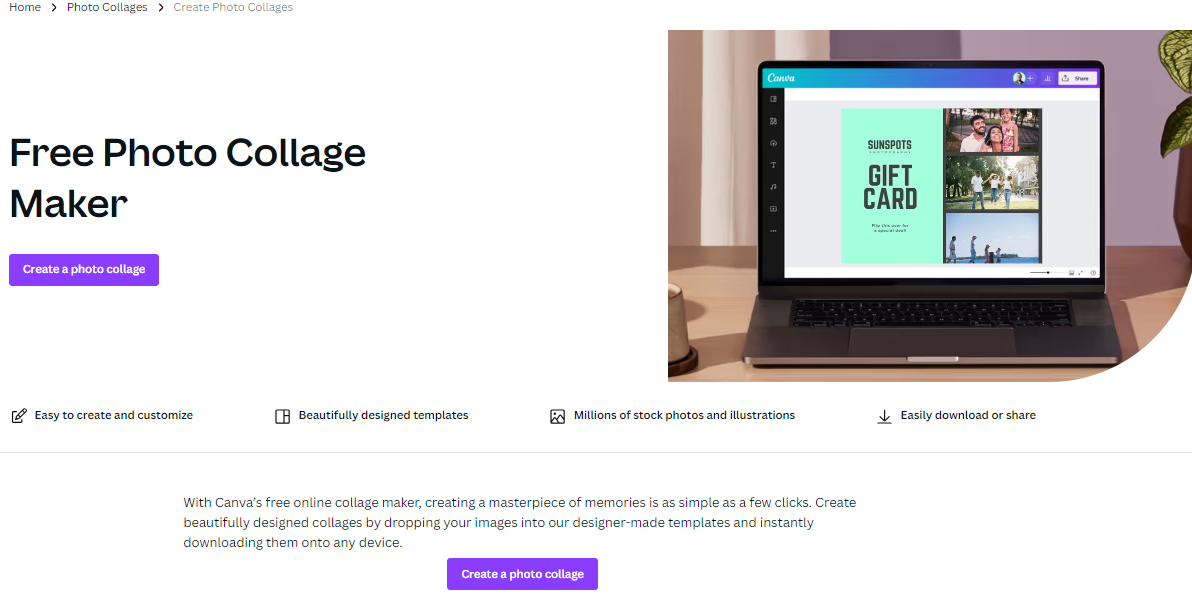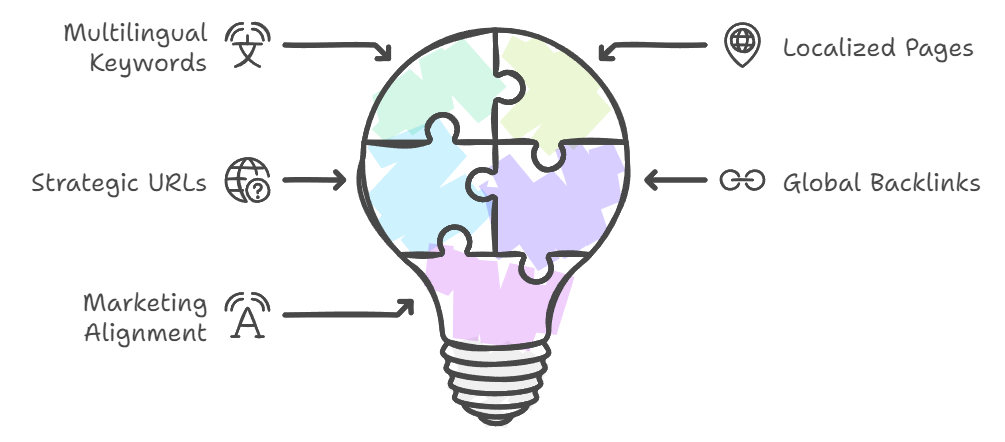Listen to this story
Overview of Canva
Canva is a leading graphic design platform that empowers users to create professional-calibre designs through an intuitive online interface.
Catering to individuals with varying design expertise, Canva Programmatic SEO offers a comprehensive library of pre-designed templates, high-quality design elements, and user-friendly tools. This versatile platform enables the creation of a broad spectrum of visual content, encompassing social media graphics, flyers, presentations, and infographics.
A brief overview of Canvas programmatic SEO strategy
Canva leverages programmatic SEO to capture organic traffic efficiently on a large scale. Here’s a breakdown of their key tactics:
- Keyword Targeting: They identify high-volume, relevant keywords users search for regarding design tools and templates.
- Automated Content Creation: Canva uses automation to generate targeted landing pages optimised for these keywords.
- Scalable Templates: These landing pages follow a structured format, allowing for an efficient content population and rapid page creation.
- Search Intent Focus: The content caters to the specific intent behind each search term, effectively addressing user needs.
- Earning Links Naturally: By providing valuable content across a vast array of design needs, Canva attracts backlinks organically.
This approach allows them to rank highly for numerous design-related searches, driving significant organic traffic to their platform.
Segregation of traffic numbers behind Canva’s programmatic SEO strategy
-
- Direct: 71.19% (565.3M)
-
- Organic Search: 17.36% (137.9M)
Canva’s traffic distribution is impressive for a few reasons:
- High Direct Traffic: A significant portion (71%) coming directly indicates strong brand awareness. Users know Canva and visit their site, suggesting brand loyalty and a user-friendly platform encouraging repeat visits and showcasing SEO optimisation benefits.
- Balance with Organic Traffic: While direct traffic is high, a healthy 17% comes from organic search. This demonstrates that Canva ranks well for relevant design-related keywords, attracting new users through search engines.
- Focus on User Experience: High direct traffic often suggests users find the platform easy to use and navigate, leading them to return directly.
Overall, this traffic breakdown reflects a strong brand with a user-friendly platform that attracts loyal users and new visitors through organic search.
Source: Semrush
Detailed Canva’s programmatic SEO strategy
190k indexed pages on Google
100M+ organic Traffic
Free {Name of the tool} Builder/Maker
-
- Free Online Resume Builder
- Free Photo Collage Maker
- Free Logo Maker
{Creative} Templates
-
- Instagram Templates
- Infographics Templates
A Deep Dive into the Structure of Canva Pages/Section
This section delves into the detailed organisation of Canvas offerings. We’ll explore the specific structure of Creative Maker Pages, Creative Templates, and Pages for Business, along with the associated data points.
Creative Maker Pages
Within this programmatic SEO strategy, Canva focuses on attracting users actively involved in design creation, encompassing both individual creators and design teams. These “Creative Maker” pages function as landing pages, aiming to convert visitors seeking specific design solutions.
To illustrate the effectiveness of this approach, let’s explore some examples of these “Creative Maker” pages and analyze the significant organic traffic they generate each month.
| Example page | Monthly organic traffic |
| Logo maker | 179k |
| Online resume builder | 71k |
| Photo collage maker | 74k |
Data Points of Pages:
To ensure optimal user experience and content relevance, Canva leverages several key data points when programmatically generating these pages.
-
- Name of the Tool/Builder
-
- CTA button
-
- Key points and description of the tool
-
- A tutorial Video on How to Use the Tool
-
- FAQs related
-
- More resources related to the tool
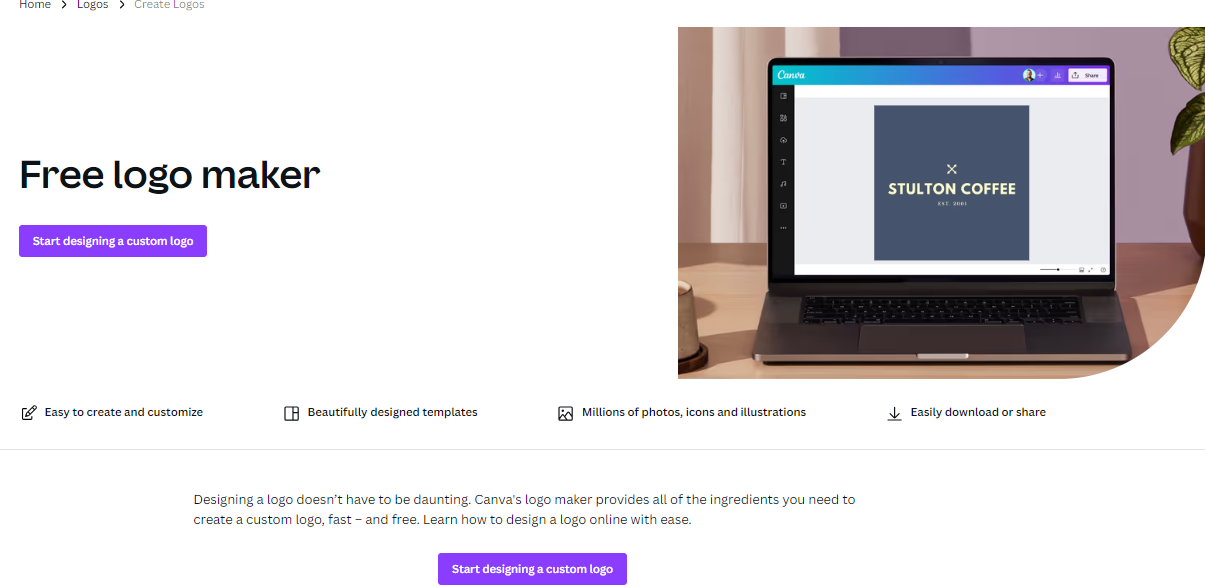
Creative Templates
Within this section, Canva prioritizes templates geared towards transactional design needs. These programmatically generated pages for “creative templates” function essentially as landing pages, aiming to convert visitors seeking specific design solutions.
Let’s now explore some example pages within this category and analyze their associated monthly organic traffic volume.
| Example page | Monthly organic traffic |
| Resume templates | 83k |
| Certificate templates | 51k |
| Business card templates | 38k |
Data Points
To optimize user experience, Canva leverages key data points on these programmatically generated pages…
-
- A title for the creative template
-
- A short description describing the template
-
- A list of templates with multiple filtering options
-
- Images of all the listed templates
-
- Each templates’ names along with their makers’ names
Pages for Business
Within this section, Canva strategically targets users seeking business-oriented solutions, signifying a transactional intent. Programmatically generated pages categorized under “business solutions” function primarily as landing pages.
To understand user behavior better, let’s explore the example pages within this area and analyze their associated traffic volume.
| Example page | Monthly organic traffic |
| Canva for sports teams | 100 |
| Canva for real estate agents | 831 |
| Photo collage maker | 100 |
Data Points
Canva strategically incorporates the following data points into its programmatically generated content…
-
- A name describing the business use case
-
- A short description
-
- A big CTA button
-
- Detailed descriptions of all features
-
- Related Templates
-
- Case Studies
-
- Pricing
-
- Frequently Asked Questions section
How Canva’s international SEO approach successfully executed with programmatic SEO
Canva conquers global SEO with programmatic muscle. Here’s the key:
-
- Multilingual Keywords: They target high-volume search terms, factoring in cultural nuances for each language and region.
-
- Localized Pages: Programmatic SEO generates landing pages optimized for these international keywords, with content and design tailored to local preferences.
-
- Strategic URLs: URLs include location identifiers to signal regional relevance.
-
- Global Backlinks: The vast amount of localized content attracts backlinks organically, boosting global ranking.
-
- Marketing Alignment: Programmatic SEO integrates seamlessly with international marketing efforts for consistent messaging.
This winning combo lets Canva target global audiences effectively, driving impressive organic traffic and solidifying their design platform dominance worldwide. Following is the impressive results canva has achieve with programmatic SEO in various Countries:
| Brazil | www.canva.com/pt_br | 13.3M |
| Mexico | www.canva.com/es_mx | 11.1M |
| Indonesia | www.canva.com/id_id/ | 11.2M |
| Spain | www.canva.com/es_es/ | 7M |
| France | www.canva.com/fr_fr/ | 5.6M |
In-depth Analysis of Canva’s Programmatic SEO Strategy
Effectiveness of Canva’s Programmatic SEO Strategy
Canva’s programmatic SEO strategy has proven highly effective due to its focus on scalability, automation, and precision. By creating large numbers of keyword-optimized landing pages for different design templates and tools, Canva efficiently ranks for numerous long-tail keywords. For instance, the use of “Creative Templates” targets specific user needs and drives organic traffic from users searching for niche design solutions. This mass generation of content allows Canva to capture search intent at a global scale, resulting in over 100 million monthly organic visitors. The consistent internal linking and frequent content updates further strengthen this strategy by enhancing user experience and boosting rankings.
Role of Data in Canva’s Programmatic SEO Approach
Data lies at the heart of Canva’s SEO success. The company uses extensive data points such as search trends, keyword volume, and user behavior to tailor its landing pages to what users are actively searching for. Data-driven decisions enable Canva to optimize content for both general and specific searches. For instance, they analyze popular search terms like “poster templates” and “social media graphics” to craft pages that are more likely to appear in search results. This data-centric approach not only ensures high relevance to user queries but also helps Canva stay ahead of search trends and continuously improve its SEO strategy.
Comparison of Canva’s “Creative Maker Pages,” “Creative Templates,” and “Pages for Business”
Canva’s strategy varies across different categories of landing pages, each serving distinct purposes and audiences. “Creative Maker Pages” are designed for individuals looking to create personalized content, targeting more casual or beginner users. “Creative Templates,” on the other hand, cater to a broader audience seeking pre-designed solutions, often incorporating more general, popular keyword searches. “Pages for Business” serve a professional audience, offering tools for business-specific needs like presentations or marketing materials. The data points across these categories differ in terms of search intent—while templates focus on broad design needs, business pages are optimized for industry-specific terms, reflecting the varying target audiences Canva aims to capture.
Balancing Direct Traffic with Organic Search Traffic
A crucial element of Canva’s strategy is maintaining a balance between direct traffic and organic search traffic. While organic search traffic helps Canva attract new users, direct traffic—coming from repeat users—ensures long-term engagement. Canva achieves this balance by offering a seamless user experience through its web and mobile platforms, encouraging users to return directly after their initial interaction via organic search. The benefits of this balance include increased brand loyalty, higher conversion rates, and sustained traffic growth across multiple channels.
Evaluating Canva’s International SEO Approach
Canva’s international SEO strategy is a key driver of its global success. By localizing content for different languages and regions, Canva ensures that its platform is accessible and relevant to users around the world. The creation of localized landing pages, optimized for search terms in various languages, allows Canva to capture traffic from non-English speaking countries. Additionally, Canva uses geo-targeted keywords and adapts content based on local cultural and market demands. This approach ensures that Canva ranks highly in international search results, contributing to its ability to attract a global audience.
Build a programmatic SEO Strategy with uG
Witnessing Canva’s success with Programmatic SEO (pSEO) highlights its potential to drive organic traffic and user acquisition. Consider partnering with seasoned pSEO experts like upGrowth to unlock similar growth for your business. Our deep understanding of this powerful technique can propel your brand to new heights in the search engine results pages (SERPs).
Watch Now: How Canva Programmatic SEO Strategy Drives 100M+ Monthly Organic Visits
Glossary of Key Terms
- Programmatic SEO: A scalable approach to SEO that uses automation and data to create and optimize large volumes of landing pages for specific keywords.
- Organic Traffic: Website visitors who arrive at a site through unpaid search engine results, indicating natural visibility and relevance.
- Direct Traffic: Website visitors who directly type the URL into their browser, suggesting brand awareness and recall.
- Landing Page: A standalone web page designed for a specific marketing campaign, aiming to convert visitors into leads.
- Keyword Targeting: Identifying and using relevant keywords within website content and metadata to improve search engine ranking for those terms.
- Automated Content Creation: Using software or tools to automate the process of generating content, ensuring efficiency and scalability.
- Search Intent: The underlying reason or goal behind a user’s search query.
- Natural Link Earning: Acquiring backlinks to a website through the creation of high-quality, valuable content that others choose to link to organically.
- International SEO: Optimizing a website and its content for different languages and geographical regions to target a global audience.
- Multilingual Keywords: Keywords translated or adapted for different languages to target specific language speakers in search results.
- Localized Pages: Web pages specifically tailored for a particular geographical location, using relevant language, currency, and cultural references.
Segregation of traffic numbers behind Canva’s programmatic SEO strategy
-
- Direct: 71.19% (565.3M)
-
- Organic Search: 17.36% (137.9M)
Canva’s traffic distribution is impressive for a few reasons:
- High Direct Traffic: A significant portion (71%) coming directly indicates strong brand awareness. Users know Canva and visit their site, suggesting brand loyalty and a user-friendly platform encouraging repeat visits and showcasing SEO optimisation benefits.
- Balance with Organic Traffic: While direct traffic is high, a healthy 17% comes from organic search. This demonstrates that Canva ranks well for relevant design-related keywords, attracting new users through search engines.
- Focus on User Experience: High direct traffic often suggests users find the platform easy to use and navigate, leading them to return directly.
Overall, this traffic breakdown reflects a strong brand with a user-friendly platform that attracts loyal users and new visitors through organic search.
Source: Semrush
Detailed Canva’s programmatic SEO strategy
190k indexed pages on Google
100M+ organic Traffic
Free {Name of the tool} Builder/Maker
-
- Free Online Resume Builder
- Free Photo Collage Maker
- Free Logo Maker
{Creative} Templates
-
- Instagram Templates
- Infographics Templates
A Deep Dive into the Structure of Canva Pages/Section
This section delves into the detailed organisation of Canvas offerings. We’ll explore the specific structure of Creative Maker Pages, Creative Templates, and Pages for Business, along with the associated data points.
Creative Maker Pages
Within this programmatic SEO strategy, Canva focuses on attracting users actively involved in design creation, encompassing both individual creators and design teams. These “Creative Maker” pages function as landing pages, aiming to convert visitors seeking specific design solutions.
To illustrate the effectiveness of this approach, let’s explore some examples of these “Creative Maker” pages and analyze the significant organic traffic they generate each month.
| Example page | Monthly organic traffic |
| Logo maker | 179k |
| Online resume builder | 71k |
| Photo collage maker | 74k |
Data Points of Pages:
To ensure optimal user experience and content relevance, Canva leverages several key data points when programmatically generating these pages.
-
- Name of the Tool/Builder
-
- CTA button
-
- Key points and description of the tool
-
- A tutorial Video on How to Use the Tool
-
- FAQs related
-
- More resources related to the tool

Creative Templates
Within this section, Canva prioritizes templates geared towards transactional design needs. These programmatically generated pages for “creative templates” function essentially as landing pages, aiming to convert visitors seeking specific design solutions.
Let’s now explore some example pages within this category and analyze their associated monthly organic traffic volume.
| Example page | Monthly organic traffic |
| Resume templates | 83k |
| Certificate templates | 51k |
| Business card templates | 38k |
Data Points
To optimize user experience, Canva leverages key data points on these programmatically generated pages…
-
- A title for the creative template
-
- A short description describing the template
-
- A list of templates with multiple filtering options
-
- Images of all the listed templates
-
- Each templates’ names along with their makers’ names
Pages for Business
Within this section, Canva strategically targets users seeking business-oriented solutions, signifying a transactional intent. Programmatically generated pages categorized under “business solutions” function primarily as landing pages.
To understand user behavior better, let’s explore the example pages within this area and analyze their associated traffic volume.
| Example page | Monthly organic traffic |
| Canva for sports teams | 100 |
| Canva for real estate agents | 831 |
| Photo collage maker | 100 |
Data Points
Canva strategically incorporates the following data points into its programmatically generated content…
-
- A name describing the business use case
-
- A short description
-
- A big CTA button
-
- Detailed descriptions of all features
-
- Related Templates
-
- Case Studies
-
- Pricing
-
- Frequently Asked Questions section
How Canva’s international SEO approach successfully executed with programmatic SEO
Canva conquers global SEO with programmatic muscle. Here’s the key:
-
- Multilingual Keywords: They target high-volume search terms, factoring in cultural nuances for each language and region.
-
- Localized Pages: Programmatic SEO generates landing pages optimized for these international keywords, with content and design tailored to local preferences.
-
- Strategic URLs: URLs include location identifiers to signal regional relevance.
-
- Global Backlinks: The vast amount of localized content attracts backlinks organically, boosting global ranking.
-
- Marketing Alignment: Programmatic SEO integrates seamlessly with international marketing efforts for consistent messaging.
This winning combo lets Canva target global audiences effectively, driving impressive organic traffic and solidifying their design platform dominance worldwide. Following is the impressive results canva has achieve with programmatic SEO in various Countries:
| Brazil | www.canva.com/pt_br | 13.3M |
| Mexico | www.canva.com/es_mx | 11.1M |
| Indonesia | www.canva.com/id_id/ | 11.2M |
| Spain | www.canva.com/es_es/ | 7M |
| France | www.canva.com/fr_fr/ | 5.6M |
In-depth Analysis of Canva’s Programmatic SEO Strategy
Effectiveness of Canva’s Programmatic SEO Strategy
Canva’s programmatic SEO strategy has proven highly effective due to its focus on scalability, automation, and precision. By creating large numbers of keyword-optimized landing pages for different design templates and tools, Canva efficiently ranks for numerous long-tail keywords. For instance, the use of “Creative Templates” targets specific user needs and drives organic traffic from users searching for niche design solutions. This mass generation of content allows Canva to capture search intent at a global scale, resulting in over 100 million monthly organic visitors. The consistent internal linking and frequent content updates further strengthen this strategy by enhancing user experience and boosting rankings.
Role of Data in Canva’s Programmatic SEO Approach
Data lies at the heart of Canva’s SEO success. The company uses extensive data points such as search trends, keyword volume, and user behavior to tailor its landing pages to what users are actively searching for. Data-driven decisions enable Canva to optimize content for both general and specific searches. For instance, they analyze popular search terms like “poster templates” and “social media graphics” to craft pages that are more likely to appear in search results. This data-centric approach not only ensures high relevance to user queries but also helps Canva stay ahead of search trends and continuously improve its SEO strategy.
Comparison of Canva’s “Creative Maker Pages,” “Creative Templates,” and “Pages for Business”
Canva’s strategy varies across different categories of landing pages, each serving distinct purposes and audiences. “Creative Maker Pages” are designed for individuals looking to create personalized content, targeting more casual or beginner users. “Creative Templates,” on the other hand, cater to a broader audience seeking pre-designed solutions, often incorporating more general, popular keyword searches. “Pages for Business” serve a professional audience, offering tools for business-specific needs like presentations or marketing materials. The data points across these categories differ in terms of search intent—while templates focus on broad design needs, business pages are optimized for industry-specific terms, reflecting the varying target audiences Canva aims to capture.
Balancing Direct Traffic with Organic Search Traffic
A crucial element of Canva’s strategy is maintaining a balance between direct traffic and organic search traffic. While organic search traffic helps Canva attract new users, direct traffic—coming from repeat users—ensures long-term engagement. Canva achieves this balance by offering a seamless user experience through its web and mobile platforms, encouraging users to return directly after their initial interaction via organic search. The benefits of this balance include increased brand loyalty, higher conversion rates, and sustained traffic growth across multiple channels.
Evaluating Canva’s International SEO Approach
Canva’s international SEO strategy is a key driver of its global success. By localizing content for different languages and regions, Canva ensures that its platform is accessible and relevant to users around the world. The creation of localized landing pages, optimized for search terms in various languages, allows Canva to capture traffic from non-English speaking countries. Additionally, Canva uses geo-targeted keywords and adapts content based on local cultural and market demands. This approach ensures that Canva ranks highly in international search results, contributing to its ability to attract a global audience.
Build a programmatic SEO Strategy with uG
Witnessing Canva’s success with Programmatic SEO (pSEO) highlights its potential to drive organic traffic and user acquisition. Consider partnering with seasoned pSEO experts like upGrowth to unlock similar growth for your business. Our deep understanding of this powerful technique can propel your brand to new heights in the search engine results pages (SERPs).
Watch Now: How Canva Programmatic SEO Strategy Drives 100M+ Monthly Organic Visits
Glossary of Key Terms
- Programmatic SEO: A scalable approach to SEO that uses automation and data to create and optimize large volumes of landing pages for specific keywords.
- Organic Traffic: Website visitors who arrive at a site through unpaid search engine results, indicating natural visibility and relevance.
- Direct Traffic: Website visitors who directly type the URL into their browser, suggesting brand awareness and recall.
- Landing Page: A standalone web page designed for a specific marketing campaign, aiming to convert visitors into leads.
- Keyword Targeting: Identifying and using relevant keywords within website content and metadata to improve search engine ranking for those terms.
- Automated Content Creation: Using software or tools to automate the process of generating content, ensuring efficiency and scalability.
- Search Intent: The underlying reason or goal behind a user’s search query.
- Natural Link Earning: Acquiring backlinks to a website through the creation of high-quality, valuable content that others choose to link to organically.
- International SEO: Optimizing a website and its content for different languages and geographical regions to target a global audience.
- Multilingual Keywords: Keywords translated or adapted for different languages to target specific language speakers in search results.
- Localized Pages: Web pages specifically tailored for a particular geographical location, using relevant language, currency, and cultural references.

